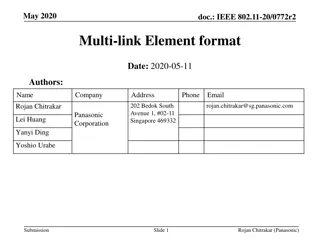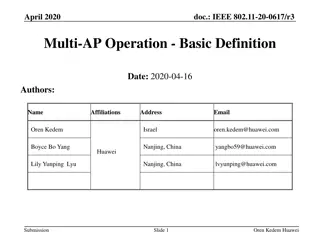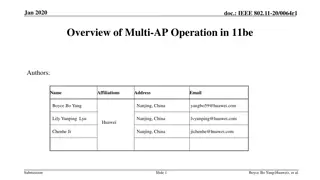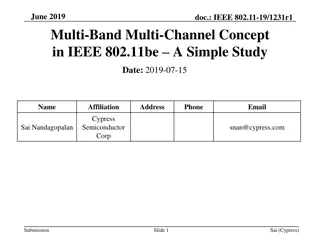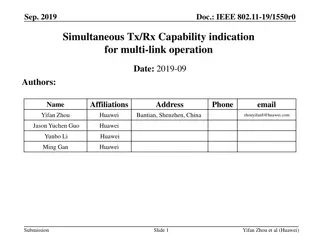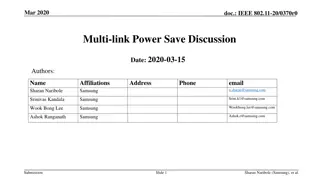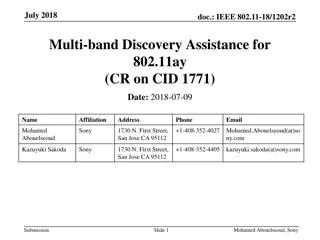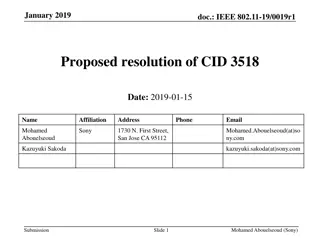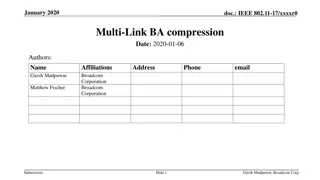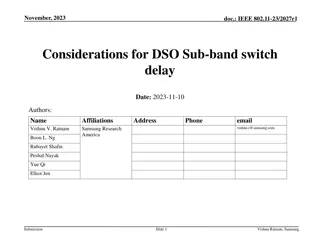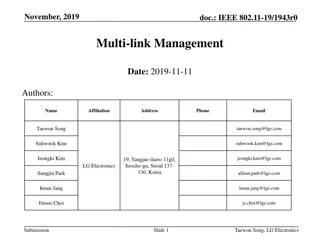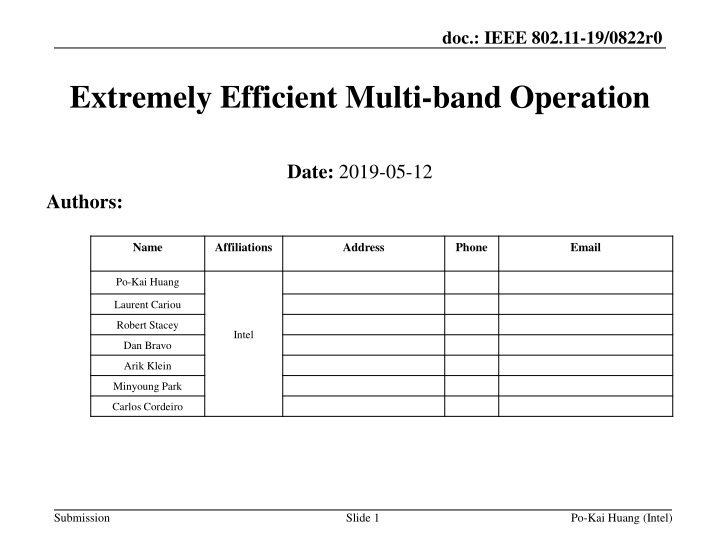
Efficient Multi-band Operation in IEEE 802.11-19
This document presents the concept of extremely efficient multi-band operation in IEEE 802.11-19, focusing on minimizing MAC overhead and the need for renegotiation. It explores the key use cases, motivation, and simulations related to multi-band/multi-channel aggregation and operation. The goal is to enhance load balancing, aggregation, and peak throughput while reducing management/data plane renegotiations.
Download Presentation

Please find below an Image/Link to download the presentation.
The content on the website is provided AS IS for your information and personal use only. It may not be sold, licensed, or shared on other websites without obtaining consent from the author. If you encounter any issues during the download, it is possible that the publisher has removed the file from their server.
You are allowed to download the files provided on this website for personal or commercial use, subject to the condition that they are used lawfully. All files are the property of their respective owners.
The content on the website is provided AS IS for your information and personal use only. It may not be sold, licensed, or shared on other websites without obtaining consent from the author.
E N D
Presentation Transcript
doc.: IEEE 802.11-19/0822r0 Extremely Efficient Multi-band Operation Date: 2019-05-12 Authors: Name Affiliations Address Phone Email Po-Kai Huang Laurent Cariou Robert Stacey Intel Dan Bravo Arik Klein Minyoung Park Carlos Cordeiro Submission Slide 1 Po-Kai Huang (Intel)
doc.: IEEE 802.11-19/0822r0 Abstract Multi-band operation is a feature agreed in EHT PAR [1] Multi-band/multi-channel aggregation and operation We discuss the need to have extremely efficient multi- band operation, which minimizes the MAC overhead, and propose the multi-link framework to accommodate the key use case We will explain why the term link is used Submission Slide 2 Po-Kai Huang (Intel)
doc.: IEEE 802.11-19/0822r0 Motivation Except aggregation, there are existing mechanisms to achieve multi-band operation (like STA switch or TID switch or OCT), but there may still be significant MAC overhead related to the operation Ex. for nontransparent FST, the need to reassociate or the need to renegotiate for different operation (ex. TWT, key, BA, etc) We think extremely efficient multi-band operation, which minimizes the MAC overhead for renegotiation, should be one of the focus topics Avoiding renegotiation is also a natural direction for us to enable aggregation Submission Po-Kai Huang (Intel) Slide 3
doc.: IEEE 802.11-19/0822r0 Simulation We simulate load balancing operation for two bands and 30 STAs (see Appendix for the details) based on the frequency of STA switch, and we observe that for low delay performance (ex less than 1s), it is required to have more than 5 STA switches every second (on average) as shown below BF = k means doing load balancing operation every k seconds The results show that extremely efficient multi-band operation that minimize the MAC overhead is critical Submission Slide 4 Po-Kai Huang (Intel)
doc.: IEEE 802.11-19/0822r0 Summary of Key Use Cases Steering/load balancing: More efficient manner to achieve seamless steering/load balancing among multiple APs/BSSs Existing use case of MBO/FST/11v, etc Aggregation: aggregate the data transmitted in different APs/BSSs as one Increase the peak throughput by enabling simultaneous operations in different links The key enhancement is to eliminate the need of various management/data plane renegotiations Ideally, we want a unified framework to achieve the above two use cases Submission Slide 5 Po-Kai Huang (Intel)
doc.: IEEE 802.11-19/0822r0 Existing Framework General Infrastructure Distribution System Medium (DSM) Distribution System (DS) AP1 operating on 2.4 GHz AP3 operating on 6 GHz AP2 operating on 5 GHz STA1 Link Link Link Link Non-AP STA1 Non-AP STA3 Non-AP STA2 STA2 AP/non-AP STA has an address to communicate to DSM, which may not be the address used on WM NOTE - link: In the context of an IEEE 802.11 medium access control (MAC) entity, a physical path consisting of exactly one traversal of the wireless medium (WM) that is usable to transfer MAC service data units (MSDUs) between two stations (STAs). Submission Slide 6 Po-Kai Huang (Intel)
doc.: IEEE 802.11-19/0822r0 General Framework Multi-link logical entity 1 STA1.1 STA1.2 STA1.3 Align with existing architecture Link 1 Link 2 Link 3 STA2.1 STA2.2 STA2.3 Multi-link logical entity 2 This framework does not need change of the current 802.11 spec definition about STA and link: station (STA): A logical entity that is a singly addressable instance of a medium access control (MAC) and physical layer (PHY) interface to the wireless medium (WM). link: In the context of an IEEE 802.11 medium access control (MAC) entity, a physical path consisting of exactly one traversal of the wireless medium (WM) that is usable to transfer MAC service data units (MSDUs) between two stations (STAs). Submission
doc.: IEEE 802.11-19/0822r0 Infrastructure Framework Example 1 Example 2 Multi-link AP logical entity Multi-link AP logical entity AP2 operating on 5 GHz configuration 1 AP3 operating on 5 GHz configuration 2 AP1 operating on 2.4 GHz AP2 operating on 5 GHz AP3 operating on 6 GHz AP1 operating on 2.4 GHz DS DSM Link 1 Link 2 Link 3 Link 1 Link 2 Link 3 Non-AP STA1 Non-AP STA2 Non-AP STA3 Non-AP STA1 Non-AP STA2 Non-AP STA3 Multi-link non-AP logical entity Multi-link non-AP logical entity Multi-link AP logical entity/Multi-link non-AP logical entity has an address to communicate to DSM, which may not be the address used on each WM Submission
doc.: IEEE 802.11-19/0822r0 Definition Multi-link logical entity: A logical entity that contains one or more STAs. The logical entity has one MAC data service interface and primitives to the LLC and a single address associated with the interface, which can be used to communicate on the DSM. NOTE A Multi-link logical entity allows STAs within the multi-link logical entity to have the same MAC address NOTE The exact name can be changed Multi-link AP logical entity: A multi-link logical entity, where each STA within the multi-link logical entity is an AP. Multi-link non-AP logical entity: A multi-link logical entity, where each STA within the multi-link logical entity is a non-AP STA. Submission
doc.: IEEE 802.11-19/0822r0 Steering/load balancing Use Case under the Framework Multi-link AP logical entity Multi-link AP logical entity DS AP1 operating on 2.4 GHz AP2 operating on 5 GHz AP3 operating on 6 GHz AP1 operating on 2.4 GHz AP2 operating on 5 GHz AP3 operating on 6 GHz DSM TBD Mechanism Link 1 Link 2 Link 3 Link 1 Link 2 Link 3 Non-AP STA1 Non-AP STA2 Non-AP STA3 Non-AP STA1 Non-AP STA2 Non-AP STA3 Multi-link non-AP logical entity Multi-link non-AP logical entity Submission
doc.: IEEE 802.11-19/0822r0 Aggregation Use case under the Framework Multi-link AP logical entity Multi-link AP logical entity AP1 operating on 2.4 GHz AP2 operating on 5 GHz AP3 operating on 6 GHz AP1 operating on 2.4 GHz AP2 operating on 5 GHz AP3 operating on 6 GHz DS DSM TBD Mechanism Link 1 Link 2 Link 3 Link 1 Link 2 Link 3 Non-AP STA1 Non-AP STA2 Non-AP STA3 Non-AP STA1 Non-AP STA2 Non-AP STA3 Multi-link non-AP logical entity Multi-link non-AP logical entity Submission
doc.: IEEE 802.11-19/0822r0 Multi-link Setup Traditionally, a non-AP STA associates with a AP to start the operation, and the association provides the following functionalities: Capability exchange Routing: DS determines a unique answer to the question, Which AP is serving STA X? Allow exchange of class 1, 2, 3 frames Under the framework, we can define a new concept called multi-link setup between a multi-link non-AP logical entity and a multi-link AP logical entity to achieve the functionalities of traditional association under the new framework Capability for different bidirectional links (ex. configuration of the link, AP capability, non-AP STA capability) can be exchanged through multi-link setup For the distribution system (DS), the multi-link AP logical entity serves the multi- link non-AP logical entity after the multi-link setup Exchange of class 1, 2, 3 frames is allowed at bidirectional links with exchanged capability Slide 12 Submission Po-Kai Huang (Intel)
doc.: IEEE 802.11-19/0822r0 Conclusion We discuss motivation to have extremely efficient steering/load balancing operation and aggregation The key enhancement is to eliminate the need of various management/data plane renegotiations to enable extremely efficient operation We propose a unified multi-link framework that addresses the key use cases (load balancing and aggregation) and keeps within the current 802.11 architecture and definition We propose to have multi-link setup to achieve the functionalities of traditional association under the new framework Slide 13 Submission Po-Kai Huang (Intel)
doc.: IEEE 802.11-19/0822r0 Straw Poll #1 - Terminology Do you support the following definition: Multi-link logical entity: A logical entity that contains one or more STAs. The logical entity has one MAC data service interface and primitives to the LLC and a single address associated with the interface, which can be used to communicate on the DSM. NOTE A Multi-link logical entity allows STAs within the multi- link logical entity to have the same MAC address NOTE The exact name can be changed Submission Slide 14 Po-Kai Huang (Intel)
doc.: IEEE 802.11-19/0822r0 Straw Poll #2 - Terminology Do you support the following definition: Multi-link AP logical entity: A multi-link logical entity, where each STA within the multi-link logical entity is an AP. Multi-link non-AP logical entity: A multi-link logical entity, where each STA within the multi-link logical entity is a non-AP STA. Submission Slide 15 Po-Kai Huang (Intel)
doc.: IEEE 802.11-19/0822r0 Reference [1] 11-18/1231r4 EHT draft proposed PAR Submission Slide 16 Po-Kai Huang (Intel)
doc.: IEEE 802.11-19/0822r0 Appendix Submission Slide 17 Po-Kai Huang (Intel)
doc.: IEEE 802.11-19/0822r0 Multi-band Switching The simplest form of Multi-band operation is to switch one STA from one band to another band Extremely efficient Multi-band STA switching is useful for load balancing as we will demonstrate in the following simulation AP1: Band 1 AP1: Band 1 STA1 AP2: Band 2 AP2: Band 2 STA1 Submission Slide 18 Po-Kai Huang (Intel)
doc.: IEEE 802.11-19/0822r0 Simulation Setup - Buffered Video Stream Consider two bands: Band 1: Rate R1 = 4*R2 Band 2: Rate R2 Note Band 2 is like 2.4 GHz band with 20 MHz bandwidth, and Band 1 is like 5 GHz band with 80 MHz bandwidth N STAs among two bands Each STA has buffered video steaming traffic model (one of BV1 to BV6 in [2]) with average 0.89 MBps across STAs Packet size 1500 bytes See [2] for details of buffered video steaming traffic model Set R2 = 10 MBps, N=30 Around 53% load =(30*0.89 M)/(5*10 M) Parameters can be adjusted to create different load situation Submission Slide 19 Po-Kai Huang (Intel)
doc.: IEEE 802.11-19/0822r0 Load Balancing Problem At a specific time, choose xi, yi that solve the following optimization problem min |t1-t2| t1 = (x1*S1+ +xn*Sn)/R1 t2 = (y1*S1+ +yn*Sn)/R2 xi+yi = 1 xi is 0 or 1 yi is 0 or 1 where xi is a indicator variable for station i in Band 1 yi is a indicator variable for station i in Band 2 Si is the sum of packet size (with unit of bytes) of STA i R1 is the rate of Band 1 with unit of bytes per second R2 is the rate of Band 2 with unit of bytes per second Balance frequency (BF) =k means solving the problem every k seconds Slide 20 Submission Po-Kai Huang (Intel)
doc.: IEEE 802.11-19/0822r0 Scheduling Algorithm Multi-band round robin: Maintain a list of all STAs in all bands in order Each STA has a FIFO queue for the arriving packets For a band, serve each STA up to 4 ms in the band based on the order of the list After a STA is served, put the STA to the end of the list Example: Assume a total list (1, 2, 3, 4, 5, 6) If Band 1 has STA 1, 3, 5 Band 1 STAs service order: 1, 3, 5 Band 2 STAs service order: 2, 4, 6 After STA1 and STA2 are served, total list becomes (3, 4, 5, 6, 1, 2) Assume that after load balancing algorithm, Band 1 has STA 1, 2, 3, 5 with total list (3, 4, 5, 6, 1, 2) Band 1 STAs service order: 3, 5, 1, 2 Band 2 STAs service order: 4, 6 After STA1 and STA4 are served, total list becomes (5, 6, 1, 2, 3, 4) Submission Slide 21 Po-Kai Huang (Intel)
doc.: IEEE 802.11-19/0822r0 Average Delay As the value of Balance frequency (BF) decreases, the average delay performance across STA decreases The average delay is ??????_??_??????_???????_??????_????(????? _????_??_??????_??????_? ???????_????_??_??????_??????_?) ??????_??????_? ??????_??_??????_???????_??????_???? Submission Slide 22 Po-Kai Huang (Intel)
doc.: IEEE 802.11-19/0822r0 Results for Buffered Video Stream Setup For low delay performance (ex BF=4, average delay is less than 1s), it is required to have around 5 STA switches every second (on average) as shown below Submission Slide 23 Po-Kai Huang (Intel)
doc.: IEEE 802.11-19/0822r0 Simulation Setup - File Transfer We try the file transfer traffic model in [2] and get similar conclusion Consider two bands: Band 1: Rate R1 = 4*R2 Band 2: Rate R2 Note Band 2 is like 2.4 GHz with 20 MHz, and Band 1 is like 5 GHz with 80 MHz N STAs among two bands Each STA has file size with distribution equal to truncated lognormal [2] with Mean = 2 Mbytes SD = 0.722 Mbytes Max = 5 Mbytes Interarrival time: exponential distribution with mean T Each file is breaking into MPDUs with size 1500 bytes Set R2 = 1.625 MBps, N=30, T= integer chosen between 8 and 28 seconds with average 18 across STAs Around 41% load =(30*2 M/18)/(5*1.625 M) Parameters can be adjusted to create different load situation Size Packet Packet T Submission Slide 24 Po-Kai Huang (Intel)
doc.: IEEE 802.11-19/0822r0 Results for File Transfer Setup For low delay performance (ex BF=2, average delay is around 1s), it is required to have around 3 STA switches every second (on average) as shown below Submission Slide 25 Po-Kai Huang (Intel)





